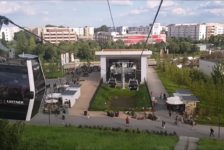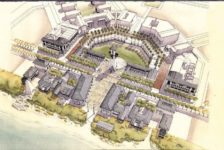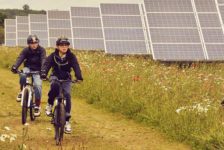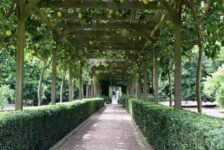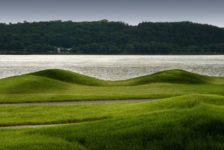
Today, landscape architects and designers have access to an unprecedented variety of plant species and hardscape materials. Thanks to modern advances in distribution, cutting-edge greenhouse technologies, streamlined inventory systems, and online resources our choices have expanded dramatically, no matter where we practice. However, this abundance can lead to decision fatigue, or conversely, complacency—repeatedly specifying a limited selection of exotic plants or standard materials simply out of habit and reconfiguring them for each site. Corporate or institutional clients and homeowners face similar challenges, turning to landscape architects for guidance not only for achieving aesthetic clarity but also to distill the options, reduce unnecessary complexity, and, crucially, design in a way that actively supports resilience and biodiversity, and reduces greenhouse gas emissions.
Though often seen as ‘green,’ the landscape industry isn’t always as sustainable as it appears. Digital tools such as the Pathfinder app by Climate Positive Design help designers make more ecologically responsible choices by offering a ‘use this, not that’ approach, for both materials and plants. The tool also quantifies a project’s environmental impact, including carbon sequestration from plants, allowing users to measure the benefits of sustainable decision making and to test different solutions from a climate positive perspective.
Research has shown that about 70 percent of a site’s plants must be regionally native to maintain healthy food webs. If the proportion of non-native plants exceeds 30 percent, the food web begins to break down, leading to decreased reproduction and survival rates in species reliant on insects for food. These are the species offering ecosystems services such as pest control, soil enhancement, and pollination. A recent study published in the Proceedings of the National Academy of Sciences shows that reliance on non-native plants can disrupt ecosystem functions, making native plant communities more resource hungry, shallower rooted, and less dependent on mycorrhizal associations. These shifts can significantly affect nutrient cycling, carbon storage, and water usage. To truly future-proof landscapes, we must prioritize sourcing healthy, field-grown native plants and master when to specify and how to maintain them. (Growing native plants at home enhances our understanding of their needs. Yet many landscape designers I know grow natives personally but specify exotics in their work.)
Landscape architects, designers, contractors and homeowners all share the responsibility of supporting native plant growers by leveraging their expertise, specifying their plants, and collaborating with local brokers who source directly from these growers. Supporting native and local growers also means understanding the significant up-front investment required by growers, as shrubs typically take 2 to 5 years and trees 5 to 10 years or more to reach a market-ready size. Contract growing is a valuable way to show your commitment to these businesses, ensuring the availability of specific plants. Open an idea exchange with your local grower by getting to know them and communicating your experience with natives—it will be mutually beneficial.
In projects where specifying particular businesses is restricted, such as municipal work, the Sustainable SITES Rating System provides guidance. SITES encourages the use of native and locally adapted plants, emphasizing plant performance standards, genetic diversity, and the importance of sourcing from regional growers. By specifying locally sourced native plants, landscape architects can support native growers while adhering to procurement guidelines and aligning with sustainability goals like reducing transportation emissions and enhancing biodiversity.
It’s important to note that native plant growers operate largely outside the industrialized distribution systems which often centralize growing operations in regions that may not match destination ecosystems. As a result, industrial-scale growers or distributors may oversimplify native plant selection (if they offer them at all), prioritizing species that tolerate long containerization periods, or withstand mass-market transportation, rather than those that support ecosystem resilience and biodiversity. Unlike these large operations, even sizable local native growers often rely on ecological practices such as using local wild seed and manual weed control which are harder to quantify under formal eco-certification programs. This reinforces the need for landscape architects to support local growers directly.
Large distribution networks aren’t inherently negative, but they can limit our plant choices unless we actively realign our buying practices with biodiversity and sustainability goals—ensuring that we prioritize sustainability not just in hardscape materials but in plant selection as well.
While certification programs recommended by organizations promoting green nursery practices can guide specifiers, many regional native plant growers don’t participate in these programs due to the high costs and administrative complexity involved. Similar to local organic farms, local growers often prioritize ecological practices that aren’t easily captured by broad certification standards, which tend to emphasize chemical or energy consumption. For instance, smaller native plant growers commonly collect seed from local wild populations—preserving genetic diversity and regional adaptations—rather than relying on commercially produced seed or cloned starts. They may also propagate plants in-house, favor manual weed control and appropriate mycorrhizal inoculation, and often field-grow plants under natural conditions, reducing energy and water needs and producing more resilient plants. This makes it our responsibility to proactively support local native growers who prioritize sustainability in daily practices.

When selecting plants, remember that a plant chosen for its biodiversity value isn’t just a plant—it’s a connector. As a primary producer, it transfers energy throughout ecosystems, supporting life both above and below ground, even if today it’s just a symbol on a digital plan. Once installed, a plant can help rebuild entire ecosystems. But we must carefully consider ecological niches and choose appropriate species when specifying natives. For example, native grasses like Bouteloua or Panicum can provide erosion control and bioremediation, while seasonal wildflowers such as Asclepias (milkweed) could help restore Monarch butterfly populations and decompact soil. Carefully chosen shrubs, such as Ceanothus (pictured above), offer multiple benefits—aesthetic beauty, low maintenance, nitrogen fixation to enhance soil, and climate-appropriate water use—while also supporting struggling lepidoptera species. By selecting plants for specific goals, such as supporting bird or butterfly species, we can achieve broader ecosystem benefits without sacrificing aesthetics.
The next time you review a planting plan, think of each plant as an energetic connector—providing home, food, shade, beauty, even medicine. Remember a key rule of ecology: nature’s resilience comes from functional redundancy. Every species plays a role, even if we don’t fully understand it yet. Biological insurance means nature doubles up on ecosystem services, allowing ecosystems to fail safely and recover—the essence of resilience. By diversifying your plant palette and supporting local native plant growers, you create a more resilient, future-proof landscape. Fostering both ecological and economic resilience ensures our landscapes—and the communities they support—will thrive together.
—
Resources:
- Decarbonizing Specifications: A Guide for Landscape Architects, Specifiers, and Industry Partners, ASLA
- “Naturalized species drive functional trait shifts in plant communities,” Proceedings of the National Academy of Sciences
- Pathfinder tool, Climate Positive Design
- “Nonnative plants reduce population growth of an insectivorous bird,” Proceedings of the National Academy of Sciences
- “Supply of Native Seeds Insufficient to Meet the Needs of Current and Future Ecological Restoration Projects,” National Academies of Sciences, Engineering, and Medicine
Jodie Cook, ASLA, PLA, SITES AP, is President of Jodie Cook Design in Orange County, California. In addition to landscape architecture, Sustainable SITES consulting, and program management, Jodie teaches The Sustainable Landscape and Native Garden Design at Saddleback College. Her education-based turf removal incentive program, NatureScape, was featured in the ASLA’s Smart Policies for Climate Change exhibition. She is certified in watershed-wise landscape design (WWLP), a Qualified Water Efficient Landscaper (QWEL), ReScape and USGBC Wildfire Defense and Resilient/Regenerative Firescaping certified. Jodie is also on the leadership team for ASLA’s Planting Design Professional Practice Network (PPN).
Published in Blog, Cover Story, Featured



